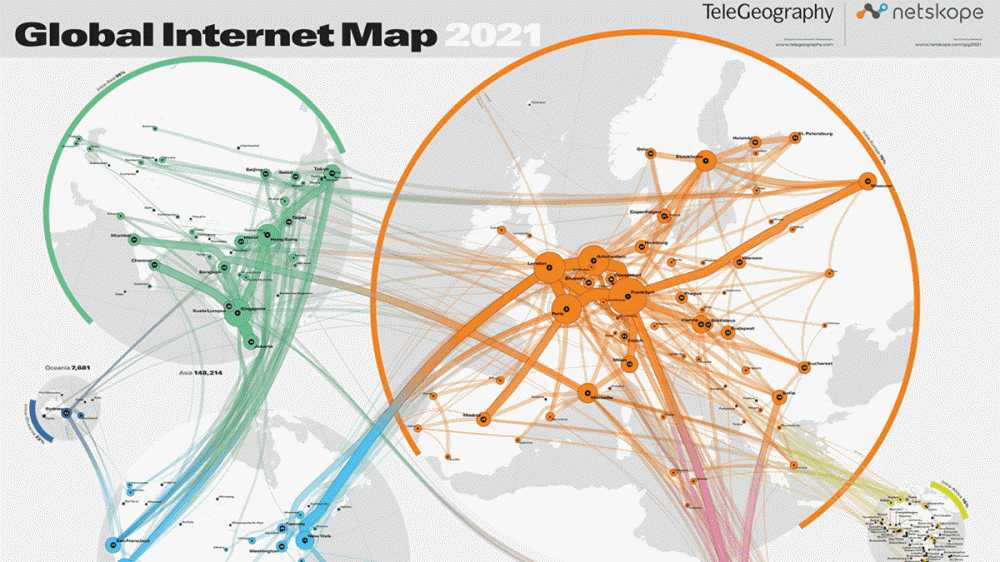
With the development of remote work and video transmission services, the global Internet has become an indispensable means in modern society. Telegeography, a market research organization related to telecommunications, draws attention by introducing the infographic Global Internet Map, which visually summarizes the status of these global Internet connections.
Displayed at the top of the infographic shows the city’s global internet connection bandwidth. The map is divided by region, with Asia in the left green, Oceania in the lower blue, and Europe in the center orange. Sky blue is North America, red is Central and South America, pink is Middle East, and yellow is Africa. The circular size represents the global internet bandwidth of the region, and the line connecting the city across the border represents the route with a bandwidth of at least 5 Gbps. In addition, this data is as of mid-2020 and does not include routes owned by private networks, as it is based on information from providers providing global Internet access services.
Asia’s global internet bandwidth is 148,214 Gbps, and cities such as Singapore, Jakarta, Chennai, Mumbai, Hanoi, Hong Kong, Beijing, Seoul and Tokyo have large bandwidths. 56% of Asian bandwidth is connected by telecommunications in Asia and the remaining 44% is connected to other regions.
Oceania bandwidth is 7,681 Gbps, and 22% of them are connected to the same Oceania country. The rest are connected to North America and Asia. Sydney has the largest bandwidth route.
The bandwidth of North America, such as the United States and Canada, is 13,703 Gbps, of which 9% of the bandwidth is connected between the United States and Canada. The rest are connected to other regions such as Central and South America, Europe, Asia and Oceania. Cities like New York, Los Angeles, San Francisco and Miami have large bandwidth routes.
Latin America’s bandwidth is 69,358 Gbps, and 20% is connected within the region. According to the infographic, almost all routes connected to Central and South America are in North America, and the Miami route is thick. Mexico City, Santiago, Buenos Aires, Sao Paulo and Rio de Janeiro are the same cities that have large bandwidth routes in Latin America.
Europe has the largest prototype, and its bandwidth is 400,000 216 Gbps. Of these, 75% are connected within Europe, and the remaining 25% are connected to North America, Africa, the Middle East, and Asia. In particular, Frankfurt, Paris, London and Amsterdam have large bandwidth routes.
Africa’s bandwidth is 17,729 Gbps, and connections account for 16% of the region. Communication routes with Europe dominate, and some communication routes in the Middle East also exist. The main routes are Rabat, Algiers, Alexandria, Lagoso, Johannesburg and Cape Town.
The Middle East bandwidth is 46,008 Gbps, but the regional connection is only 8%. From Africa, Istanbul is mainly connected to Europe, and Dubai, Libya, and Jeddah have routes to Asia and North America.
Looking at how much bandwidth available for data communication by region increased between 2016 and 2020, Europe increased rapidly, and Asia and North America also saw a nearly doubled increase in bandwidth compared to 2016. Actual data traffic is also increasing at an annual rate of 30% over the same period, more than doubled in 2020 compared to 2016. In addition, if you look at the 10 Gigabit Ethernet IP rates on average per 1Mbps, it is between $0.25 and $0.42 in North America and Europe. Johannesburg is $2.5, Sydney is $3.5, and Mumbai is $5.
Looking at the change in rates per 1Mbps in 10 Gigabit Ethernet from 2017 to 2020, prices fell sharply in Johannesburg, Sydney and Sao Paulo. In Johannesburg, it was close to $14 in 2017, but plummeted to $2.5 in 2020.
Looking at the number of Internet Exchanges, which are interconnection points for exchanging communications between countries, by country, the United States has a remarkable number of 120, and Brazil, Argentina, Russia, Australia, India, Germany, Canada, and France stand out. Related information can be found here.


















Add comment